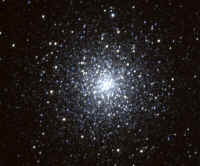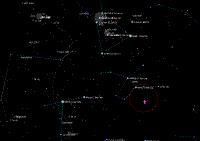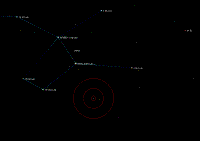M79 (globular cluster in Lepus)
490: M79 image
M79 is a beautiful globular cluster in Lepus. It was discovered by Pierre Méchain on October 26, 1780. Messier confirmed it and added it to his list on December 17, 1780. M79 is unusual in at least two respects. First, although globular clusters outnumber open clusters 29 to 27 in the Messier Catalog, M79 is the only glob in this group of 23 Winter Messier Objects. The second unusual aspect of M79 is that it is in a very unusual location for a glob. Nearly all other globs are located between us and the galactic center, so that when we look at them we’re looking into the heart of the Milky Way. M79, on the other hand, is located about 40,000 light years farther from the galactic center than we are, which is to say about 60,000 light years from the galactic center and nearly on the edge of the galaxy. When we look at M79, we’re looking towards intergalactic space.
500: M79 with binocular
At about 8.7 arcminutes in diameter and with a surface brightness of about 12.0, M79 is a very difficult object for standard binoculars. The Astronomical League rates M79 as a “Tougher” object with 7X50 binoculars. That may be true from a true dark-sky site, but from Bullington I’d rate it as at least a “Challenge”, if not impossible. I’ve never really succeeded in getting M79 in 7X50s from Bullington, although I did think I spotted it once using averted imagination. Using a telescope is a different story, however.
The first step to finding M79 is to locate the constellation Lepus. Lepus is a pretty insipid constellation. The brightest star in it, Arneb, has a visual magnitude of only 2.6, and the second brightest, Nihal, is only 2.8. Fortunately, Lepus is easy to find anyway, because it lies at the base of Orion, formed by zeroth magnitude Rigel and second magnitude Saiph. Once you locate Lepus, it’s pretty easy to zero in on M79.
510: M79 with Telrad
The trick to getting M79 in your eyepiece is to imagine the triangle formed by three third-magnitude stars in Lepus. Nihal, at magnitude 2.84 forms the apex of the triangle, with 13 Gamma Lepus at 3.6 and 2 Epsilon Lepus at 3.19 forming the base. Put the 4-degree Telrad circle just touching the imaginary baseline of that triangle just slightly to the 2 Epsilon side and Nihal side of center. M79 will be centered in a low-power eyepiece, where it will appear as a small, bright nebulous patch, about a third the diameter of the full moon. Like M78, M79 is small enough and bright enough to take some power. Once we have M79 centered, we generally use an eyepiece that yields 125X or so to put M79 in context with its surroundings.


